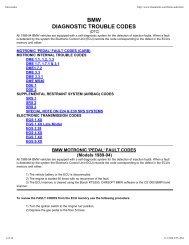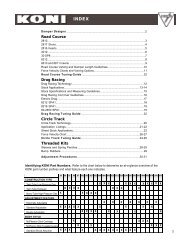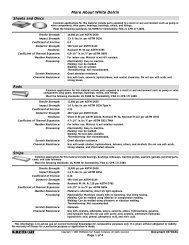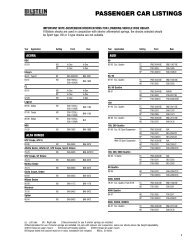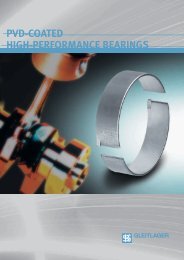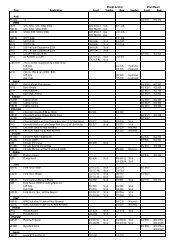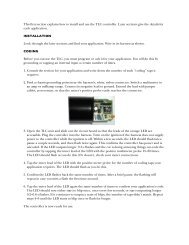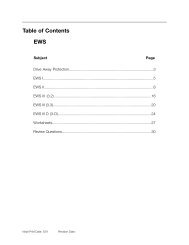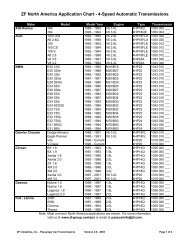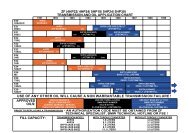Table Of Contents
Table Of Contents
Table Of Contents
You also want an ePaper? Increase the reach of your titles
YUMPU automatically turns print PDFs into web optimized ePapers that Google loves.
<strong>Table</strong> of <strong>Contents</strong><br />
Subject<br />
Page<br />
MS S54 . . . . . . . . . . . . . . . . . . . . . . . . . . . . . . . . . . . . . . . . . . . . . . . . . . . .2<br />
Objectives of the Module . . . . . . . . . . . . . . . . . . . . . . . . . . . . . . . . . . . . .2<br />
Purpose of the System . . . . . . . . . . . . . . . . . . . . . . . . . . . . . . . . . . . . . . .3<br />
System Components . . . . . . . . . . . . . . . . . . . . . . . . . . . . . . . . . . . . . . . .4<br />
Power Supply . . . . . . . . . . . . . . . . . . . . . . . . . . . . . . . . . . . . . . . . . . . . . .6<br />
Principle of Operation . . . . . . . . . . . . . . . . . . . . . . . . . . . . . . . . . . . . . . . .7<br />
Workshop Hints . . . . . . . . . . . . . . . . . . . . . . . . . . . . . . . . . . . . . . . . . . . .8<br />
Tools and Equipment . . . . . . . . . . . . . . . . . . . . . . . . . . . . . . . . . . . . . . . .9<br />
Air Management. . . . . . . . . . . . . . . . . . . . . . . . . . . . . . . . . . . . . . . . . . . . 10<br />
Principle of Operation. . . . . . . . . . . . . . . . . . . . . . . . . . . . . . . . . . . . . . . .14<br />
Workshop Hints. . . . . . . . . . . . . . . . . . . . . . . . . . . . . . . . . . . . . . . . . . . .21<br />
Tools and Equipment. . . . . . . . . . . . . . . . . . . . . . . . . . . . . . . . . . . . . . . .23<br />
Fuel Management. . . . . . . . . . . . . . . . . . . . . . . . . . . . . . . . . . . . . . . . . . .24<br />
Principle of Operation. . . . . . . . . . . . . . . . . . . . . . . . . . . . . . . . . . . . . . . 33<br />
Workshop Hints. . . . . . . . . . . . . . . . . . . . . . . . . . . . . . . . . . . . . . . . . . . .39<br />
Tools and Equipment. . . . . . . . . . . . . . . . . . . . . . . . . . . . . . . . . . . . . . . .45<br />
Ignition Management. . . . . . . . . . . . . . . . . . . . . . . . . . . . . . . . . . . . . . . . 47<br />
Principle of Operation. . . . . . . . . . . . . . . . . . . . . . . . . . . . . . . . . . . . . . . 53<br />
Workshop Hints. . . . . . . . . . . . . . . . . . . . . . . . . . . . . . . . . . . . . . . . . . . .57<br />
Tools and Equipment. . . . . . . . . . . . . . . . . . . . . . . . . . . . . . . . . . . . . . . .61<br />
Emissions Management. . . . . . . . . . . . . . . . . . . . . . . . . . . . . . . . . . . . . . 62<br />
Evaporative Emissions. . . . . . . . . . . . . . . . . . . . . . . . . . . . . . . . . . . . . . . 62<br />
Exhaust Emissions. . . . . . . . . . . . . . . . . . . . . . . . . . . . . . . . . . . . . . . . . .65<br />
Principle of Operation. . . . . . . . . . . . . . . . . . . . . . . . . . . . . . . . . . . . . . . .70<br />
Workshop Hints. . . . . . . . . . . . . . . . . . . . . . . . . . . . . . . . . . . . . . . . . . . 81<br />
Tools and Equipment . . . . . . . . . . . . . . . . . . . . . . . . . . . . . . . . . . . . . . . 82<br />
Performance Controls. . . . . . . . . . . . . . . . . . . . . . . . . . . . . . . . . . . . . . . 84<br />
Review Questions . . . . . . . . . . . . . . . . . . . . . . . . . . . . . . . . . . . . . . . . . . 88
Emissions Management<br />
Evaporative Emissions: The<br />
control of the evaporative fuel<br />
vapors (Hydrocarbons) from the<br />
fuel tank is important for the overall<br />
reduction in vehicle emissions.<br />
The evaporative system has been<br />
combined with the ventilation of<br />
the fuel tank, which allows the<br />
tank to breath (equalization). The<br />
overall operation provides:<br />
VAPORS TO EVAPORATIVE<br />
EMISSION VALVE<br />
DM-TL<br />
FILTER<br />
• An inlet vent, to an otherwise<br />
"sealed" fuel tank, for the entry<br />
of air to replace the fuel consumed<br />
during engine operation.<br />
13410095.eps<br />
• An outlet vent with a storage canister to "trap and hold" fuel vapors that are produced by<br />
the expansion/evaporation of fuel in the tank, when the vehicle is stationary.<br />
The canister is then "purged" using the engine vacuum to draw the fuel vapors into the<br />
combustion chamber. This "cleans" the canister allowing for additional storage. Like any<br />
other form of combustible fuel, the introduction of these vapors on a running engine must<br />
be controlled. The ECM controls the Evaporative Emission Valve which regulates purging of<br />
evaporative vapors.<br />
ON-BOARD REFUELING VAPOR RECOVERY (ORVR)<br />
The ORVR system recovers and stores hydrocarbon fuel vapor that was previously released<br />
during refueling. Non ORVR vehicles vent fuel vapors from the tank venting line back to the<br />
filler neck and in many states reclaimed by a vacuum receiver on the filling station’s fuel<br />
pump nozzle.<br />
When refueling, the pressure of the fuel entering the tank forces the hydrocarbon vapors<br />
through the tank vent line to the liquid/ vapor separator, through the rollover valve and into<br />
the charcoal canister.<br />
The HC is stored in the charcoal canister, and the system can then “breath” through the DM<br />
TL and the air filter.<br />
62<br />
MS S54 Emissions Management
Liquid/Vapor Separator: Fuel vapors are routed from<br />
the fuel tank filler neck through a hose to the<br />
Liquid/Vapor Separator (located in the right rear wheel<br />
well behind the trim).<br />
The vapors cool when exiting the fuel tank, the condensates<br />
separate and drain back to the fuel tank<br />
through a return hose (1). The remaining vapors exit the<br />
Liquid/ Vapor Separator to the Active Carbon Canister.<br />
134100143.eps<br />
Active Carbon Canister: As the fuel vapors enter the<br />
canister, they will be absorbed by the active carbon.<br />
The remaining air will be vented to the atmosphere<br />
through the end of the canister (passing through the<br />
DMTL and filter) allowing the fuel tank to “breath”.<br />
When the engine is running, the canister is then<br />
"purged" using intake manifold vacuum to draw fresh<br />
air through the canister which extracts the hydrocarbon<br />
vapors into the combustion chamber. This cleans the<br />
canister for additional storage. The Active Carbon<br />
Canister is located under the luggage compartment<br />
floor with the DM TL Pump.<br />
134100147.eps<br />
Evaporative Emission Valve: This ECM controlled<br />
solenoid valve (located under the intake manifold) regulates<br />
the purge flow from the Active Carbon Canister<br />
through the idle air distribution pipe into the intake<br />
manifold .<br />
The ECM Relay provides operating voltage, and the<br />
ECM controls the valve by regulating the ground circuit.<br />
The valve is powered open and closed by an internal<br />
spring.<br />
134100101.eps<br />
MS S54<br />
FROM EVAPORATIVE<br />
EMISSION CANISTER<br />
ECM RELAY<br />
If the Evaporative Emission Valve circuit is defective, a<br />
fault code will be set and the “Malfunction Indicator<br />
Light” will be illuminated. If the valve is “mechanically”<br />
defective, a driveability complaint could be encountered<br />
and a mixture related fault code will be set.<br />
134100100.eps<br />
63<br />
MS S54 Emissions Management
DMTL (Diagnosis Module - Evaporative Leakage<br />
Detection): This component ensures accurate fuel<br />
system leak detection for leaks as small as 1.0 mm<br />
(.040”) by slightly pressurizing the fuel tank and evaporative<br />
components. The DM TL pump contains an integral<br />
DC motor which is activated directly by the ECM.<br />
The ECM monitors the pump motor operating current<br />
as the measurement for detecting leaks.<br />
The pump also contains an ECM controlled change<br />
over valve that is energized closed during a Leak<br />
Diagnosis test. The change over valve is open during all<br />
other periods of operation allowing the fuel system to<br />
“breath” through the inlet filter. The DM TL is located<br />
under the luggage compartment floor with the Active<br />
Carbon Canister.<br />
13410089.eps<br />
1<br />
2<br />
1. In its inactive state, filtered fresh air enters the evaporative<br />
system through the sprung open valve of the<br />
DM TL.<br />
2. When the DME activates the DM TL for leak testing,<br />
it first activates only the pump motor. This pumps air<br />
through a restricted orifice (1.0 mm) which causes<br />
the electric motor to draw a specific amperage<br />
value. This value is equivalent to the size of the<br />
restricted.<br />
3. The solenoid valve is then energized which seals the<br />
evaporative system and directs the pump output to<br />
pressurize the evaporative system.<br />
13410088.eps<br />
3<br />
• A large leak is detected in the evaporative system if<br />
the amperage value is not achieved.<br />
• A small leak is detected if the same reference amper<br />
age is achieved.<br />
• The system is sealed if the amperage value is higher<br />
than the reference amperage.<br />
64<br />
MS S54 Emissions Management<br />
13410087.eps
Exhaust Emissions: The combustion<br />
process of a gasoline<br />
powered engine produces Carbon<br />
Monoxide (CO), Hydrocarbons<br />
(HC) and Oxides of Nitrogen<br />
(NOx).<br />
• Carbon Monoxide is a product<br />
of incomplete combustion under<br />
conditions of air deficiency.<br />
CO emissions are strongly dependent<br />
on the air/fuel ratio.<br />
• Hydrocarbons are also a product<br />
of incomplete combustion<br />
which results in unburned fuel.<br />
HC emissions are dependent on<br />
air/fuel ratio and the ignition of<br />
the mixture.<br />
134100103-1.eps<br />
• Oxides of Nitrogen are a product of peak combustion temperature (and temperature<br />
duration). NOx emissions are dependent on internal cylinder temperatures affected by<br />
the air/fuel ratio and ignition of the mixture.<br />
Control of exhaust emissions is accomplished by the engine and engine management<br />
design as well as after-treatment.<br />
• The ECM manages exhaust emissions by controlling the air/fuel ratio and ignition.<br />
• The Catalytic Converter further reduces exhaust emissions leaving the engine.<br />
Bosch LSH 25 Oxygen Sensors: The pre-cat<br />
oxygen sensors (1) measure the residual oxygen<br />
content of the exhaust gas. The sensors produces<br />
a low voltage (0-1000 mV) proportional to<br />
the oxygen content that allows the ECM to<br />
monitor the air/fuel ratio.<br />
If necessary, the ECM will “correct” the air/fuel<br />
ratio by regulating the ms injection time. The<br />
sensor is mounted in the hot exhaust stream<br />
directly in front of the catalytic converter.<br />
11410049.tiff<br />
65<br />
MS S54 Emissions Management
Ambient Air<br />
Exhaust<br />
Stream<br />
12410005.bmp<br />
1. Electrode (+) 7. External Body (Ventilated)<br />
2. Electrode (-) 8. Contact Spring<br />
3. Porous Ceramic Coating (encasing electrolyte) 9. Vent Opening<br />
4. Protective Metal Cage (Ventilated) 10. Output Lead<br />
5. Casing 11. Insulator<br />
6. Contact Sleeve 12. Exhaust Pipe Wall<br />
The “tip” of the sensor contains a microporous platinum coating (electrodes) which conduct<br />
current. The platinum electrodes are separated by solid electrolyte which conducts oxygen<br />
ions.<br />
The platinum conductors are covered with a highly porous ceramic coating and the entire<br />
tip is encased in a ventilated metal “cage”. This assembly is submersed in the exhaust<br />
stream. The sensor body (external) has a small vent opening in the housing that allows<br />
ambient air to enter the inside of the tip.<br />
The ambient air contains a constant level of oxygen content (21%) and the exhaust stream<br />
has a much lower oxygen content. The oxygen ions (which contain small electrical charges)<br />
are “purged” through the solid electrolyte by the hot exhaust gas flow. The electrical<br />
charges (low voltage) are conducted by the platinum electrodes to the sensor signal wire<br />
that is monitored by the ECM.<br />
66<br />
MS S54 Emissions Management
If the exhaust has a lower oxygen content (rich mixture), there will be a large ion “migration”<br />
through the sensor generating a higher voltage (950 mV).<br />
If the exhaust has a higher oxygen content (lean mixture), there will be a small ion “migration”<br />
through the sensor generating a lower voltage (080 mV).<br />
This voltage signal is constantly changing due to<br />
combustion variations and normal exhaust pulsations.<br />
The ECM monitors the length of time the sensors<br />
are operating in the lean, rich and rest conditions.<br />
The evaluation period of the sensors is<br />
over a predefined number of oscillation cycles.<br />
13410092.eps<br />
18410000.eps<br />
This conductivity is efficient when the oxygen<br />
sensor is hot (250º - 300º C). For this reason,<br />
the sensor contains a heating element. This<br />
“heated” sensor reduces warm up time, and<br />
retains the heat during low engine speed when<br />
the exhaust temperature is cooler.<br />
12410006.bmp<br />
67<br />
MS S54 Emissions Management
Catalytic Converter Monitoring: The efficiency of catalyst operation is determined by<br />
evaluating the oxygen storage capability of the catalytic converters using the pre and post<br />
oxygen sensor signals.<br />
A properly operating catalyst consumes or stores most of the O2 (oxygen) that is present<br />
in the exhaust gas (input to catalyst). The gases that flow into the catalyst are converted<br />
from CO, HC and NOx to CO2, H2O and N2 respectively.<br />
In order to determine if the catalysts are working<br />
correctly, post catalyst oxygen sensors (2) are<br />
installed to monitor exhaust gas content exiting<br />
the catalysts.<br />
The signal of the post cat. O2 sensor is evaluated<br />
over the course of several pre cat. O2 sensor<br />
oscillations. During the evaluation period, the<br />
signal of the post cat. sensor must remain within<br />
a relatively constant voltage range (700 - 800<br />
mV).<br />
The post cat. O2 voltage remains high with a<br />
very slight fluctuation. This indicates a further<br />
lack of oxygen when compared to the pre cat.<br />
sensor. If this signal decreased in voltage and/or<br />
increased in fluctuation, a fault code will be set<br />
for Catalyst Efficiency and the “Malfunction<br />
Indicator Light” will illuminate.<br />
Secondary Air Injection: In order to reduce<br />
HC and CO emissions during engine warm up,<br />
an electric Air Pump (2) and Air Injection Valve (1)<br />
direct fresh air through an internal channel in the<br />
cylinder head into the exhaust ports. The Air<br />
Injection Valve is opened by air pressure and<br />
closed by an internal spring.<br />
LOW<br />
OXYGEN<br />
HIGH<br />
OXYGEN<br />
134100104.eps<br />
11410049.tiff<br />
Secondary Air injection also provides:<br />
• Reduction in catalyst warm-up time<br />
• Accelerated hydrocarbon Oxidation<br />
134100104.tiff<br />
68<br />
MS S54 Emissions Management
Misfire Detection: As part of the OBD II regulations the ECM must determine misfire and<br />
also identify the specific cylinder(s), the severity of the misfire and whether it is emissions<br />
relevant or catalyst damaging based on monitoring crankshaft acceleration.<br />
In order to accomplish these tasks the ECM monitors the crankshaft for acceleration by the<br />
impulse wheel segments of cylinder specific firing order. The misfire/engine roughness calculation<br />
is derived from the differences in the period duration of individual increment gear<br />
segments.<br />
Each segment period consist of<br />
an angular range of 90° crank<br />
angle that starts 54° before Top<br />
Dead Center.<br />
If the expected period duration<br />
is greater than the permissible<br />
value a misfire fault for the particular<br />
cylinder is stored in the fault<br />
memory of the ECM.<br />
MS S54<br />
Depending on the level of misfire<br />
rate measured the ECM will illuminate<br />
the “Malfunction Indicator<br />
Light”, deactivate the specific<br />
fuel injector to the particular<br />
cylinder and switch lambda<br />
operation to open-loop.<br />
134100101.eps<br />
In order to eliminate misfire faults that can occur as a result of varying flywheel tolerances<br />
(manufacturing process) an internal adaptation of the flywheel is made. The adaptation is<br />
made during periods of decel fuel cut-off in order to avoid any rotational irregularities which<br />
the engine can cause during combustion. This adaptation is used to correct segment duration<br />
periods prior to evaluation for a misfire event.<br />
If the sensor wheel adaptation has not been completed the misfire thresholds are limited to<br />
engine speed dependent values only and misfire detection is less sensitive. The crankshaft<br />
sensor adaptation is stored internally and is not displayed via DISplus or MoDIC. If the<br />
adaptation limit is exceeded a fault will be set.<br />
69<br />
MS S54 Emissions Management
Principle of Operation<br />
Emissions Management controls evaporative and exhaust emissions. The ECM monitors<br />
the fuel storage system for evaporative leakage and controls the purging of evaporative<br />
fuel. The ECM monitors and controls the exhaust emissions by regulating the combustible<br />
mixture and after treating by injecting fresh air into the exhaust system. The catalytic converter<br />
further breaks down remaining combustible exhaust gases and is monitored by the<br />
ECM for catalyst efficiency.<br />
12410016.eps<br />
The Evaporative Leakage Detection is performed on the fuel storage system by the DM<br />
TL pump which contains an integral DC motor that is activated by the ECM. The ECM monitors<br />
the pump motor operating current as the measurement for detecting leaks.<br />
The pump also contains an ECM controlled change over valve that is energized closed during<br />
a Leak Diagnosis test. The ECM only initiates a leak diagnosis test every second time<br />
the criteria are met. The criteria is as follows:<br />
• Engine OFF with ignition switched OFF.<br />
• ECM still in active state or what is known as “follow up mode” (ECM Relay energized,<br />
ECM and components online for extended period after key off).<br />
• Prior to Engine/Ignition switch OFF condition, vehicle must have been driven for a minimum<br />
of 20 minutes.<br />
• Prior to minimum 20 minute drive, the vehicle must have been OFF for a minimum of 5<br />
hours.<br />
70<br />
MS S54 Emissions Management
• Fuel Tank Capacity must be between 15 and 85% (safe approximation between 1/4 -<br />
3/4 of a tank).<br />
• Ambient Air Temperature between -7 O C & 35 O C (20 O F & 95 O F )<br />
• Altitude < 2500m (8,202 feet).<br />
• Battery Voltage between 11.5 and 14.5 Volts<br />
When these criteria are satisfied every second time, the ECM will start the Fuel System<br />
Leak Diagnosis Test. The test will typically be carried out once a day ie:, once after driving<br />
to work in the morning, when driving home in the evening, the criteria are once again met<br />
but the test is not initiated. The following morning, the test will run again.<br />
PHASE 1 - REFERENCE MEASUREMENT<br />
The ECM activates the pump motor. The pump pulls air from the filtered air inlet and passes<br />
it through a precise 1.0 mm reference orifice in the pump assembly.<br />
The ECM simultaneously monitors the pump motor current flow. The motor current raises<br />
quickly and levels off (stabilizes) due to the orifice restriction. The ECM stores the stabilized<br />
amperage value in memory. The stored amperage value is the electrical equivalent of a 1.0<br />
mm (0.040”) leak.<br />
PHASE 2 - LEAK DETECTION<br />
The ECM energizes the Change Over Valve allowing the pressurized air to enter the fuel<br />
system through the Charcoal Canister. The ECM monitors the current flow and compares<br />
it with the stored reference measurement over a duration of time.<br />
Once the test is concluded, the ECM stops the pump motor and immediately de-energizes<br />
the change over valve. This allows the stored pressure to vent thorough the charcoal canister<br />
trapping hydrocarbon vapor and venting air to atmosphere through the filter.<br />
71<br />
MS S54 Emissions Management
TEST RESULTS<br />
The time duration varies between 45 & 270 seconds depending on the resulting leak diagnosis<br />
test results (developed tank pressure “amperage” / within a specific time period).<br />
However the chart below depicts the logic used to determine fuel system leaks.<br />
1.0<br />
1.0<br />
134100100.eps<br />
If the ECM detects a leak, a fault will be stored and the “Malfunction Indicator Light” will be<br />
illuminated. Depending on the amperage measurement detected by the ECM, the fault<br />
code displayed will be “small leak” or “large leak”.<br />
If the vehicle was refueled and the filler cap was not properly<br />
installed, the “Check Filler Cap” message will be displayed.<br />
The ECM detects refueling from a change in the fuel tank<br />
sending unit level via the Instrument Cluster. Upon a restart<br />
and driving the vehicle, the leakage test will be performed. If<br />
the ECM detects leakage, the “Check Filler Cap” light will<br />
illuminate in the lower left corner of the instrument cluster.<br />
If the filler cap is installed and there is no leakage present the<br />
next time the leakage test is performed, the “Malfunction<br />
Indicator Light” will not be illuminated.<br />
72<br />
MS S54 Emissions Management<br />
Check<br />
Filler<br />
Cap<br />
62410002.
Evaporative Emission Purging is regulated by the ECM controlling the Evaporative<br />
Emission Valve. The Evaporative Emission Valve is a solenoid that regulates purge flow from<br />
the Active Carbon Canister into the intake manifold. The ECM Relay provides operating<br />
voltage, and the ECM controls the valve by regulating the ground circuit. The valve is powered<br />
open and closed by an internal spring.<br />
FROM EVAPORATIVE<br />
EMISSION CANISTER<br />
The “purging” process takes place when:<br />
• Oxygen Sensor Control is active<br />
• Engine Coolant Temperature is >60º C<br />
• Engine Load is present<br />
MS S54<br />
ECM RELAY<br />
The Evaporative Emission Valve is opened in stages to moderate the purging.<br />
134100100.<br />
• Stage 1 opens the valve for 10 ms (milli-seconds) and then closes for 150 ms.<br />
• The stages continue with increasing opening times (up to 16 stages) until the valve is<br />
completely open.<br />
• The valve now starts to close in 16 stages in reverse order<br />
• This staged process takes 6 minutes to complete. The function is inactive for 1 minute<br />
then starts the process all over again.<br />
• During the purging process the valve is completely opened during full throttle operation<br />
and is completely closed during deceleration fuel cutoff.<br />
Evaporative Purge System Flow Check is performed by the ECM when the oxygen<br />
sensor control and purging is active. When the Evaporative Emission Valve is open the ECM<br />
detects a rich/lean shift as monitored by the oxygen sensors indicating the valve is functioning<br />
properly.<br />
If the ECM does not detect a rich/lean shift, a second step is performed when the vehicle<br />
is stationary and the engine is at idle speed. The ECM opens and close the valve (abruptly)<br />
several times and monitors the engine rpm for changes. If there are no changes, a fault<br />
code will be set.<br />
73<br />
MS S54 Emissions Management
Fuel System Monitoring is an<br />
OBD II requirement which monitors<br />
the calculated injection time<br />
(ti) in relation to engine speed,<br />
load, and the pre catalytic converter<br />
oxygen sensor(s) signals as<br />
a result of the residual oxygen in<br />
the exhaust stream.<br />
The ECM uses the pre catalyst<br />
oxygen sensor signals as a correction<br />
factor for adjusting and<br />
optimizing the mixture pilot control<br />
under all engine operating<br />
conditions.<br />
Adaptation Values are stored by the ECM In order to maintain an "ideal" air/fuel ratio.<br />
The ECM is capable of adapting to various environmental conditions encountered while the<br />
vehicle is in operation (changes in altitude, humidity, ambient temperature, fuel quality, etc.).<br />
The adaptation can only make slight corrections and can not compensate for large<br />
changes which may be encountered as a result of incorrect airflow or incorrect fuel supply<br />
to the engine.<br />
Within the areas of adjustable adaption, the ECM modifies the injection rate under two<br />
areas of engine operation:<br />
• During idle and low load mid range engine speeds (Additive Adaptation),<br />
134100100.eps<br />
• During operation under a normal to higher load when at higher engine speeds<br />
(Multiplicative Adaptation).<br />
These values indicate how the ECM is compensating for a less than ideal initial air/fuel ratio.<br />
NOTE: If the adaptation value is greater than "0.0 ms" the ECM is trying to richen the mixture.<br />
If the adaptation value is less then "0.0 ms the ECM is trying to lean-out the mixture.<br />
74<br />
MS S54 Emissions Management
Catalyst Monitoring is performed by the ECM under oxygen sensor closed loop operation.<br />
The changing air/fuel ratio in the exhaust gas results in lambda oscillations at the precatalyst<br />
sensors. These oscillations are dampened by the oxygen storage activity of the<br />
catalysts and are reflected at the post catalyst sensors as a fairly stable signal (indicating<br />
oxygen has been consumed). Conditions for Catalyst Monitoring:<br />
Requirements<br />
Status/Condition<br />
• Closed loop operation<br />
YES<br />
• Engine coolant temperature Operating Temp.<br />
• Vehicle road speed<br />
3 - 50 MPH (5 to 80 km/h)<br />
• Catalyst temperature (calculated)* 350°C to 650°C<br />
• Throttle angle deviation<br />
Steady throttle<br />
• Engine speed deviation<br />
Steady/stable engine speed<br />
• Average lambda value deviation Steady/stable load<br />
* Catalyst temperature is an internally calculated value that is a function of load/air mass<br />
and time.<br />
Note: The catalyst efficiency is monitored once per trip while the vehicle is in closed loop<br />
operation.<br />
As part of the monitoring process, the pre and<br />
post O2 sensor signals are evaluated by the<br />
ECM to determine the length of time each sensor<br />
is operating in the rich and lean range.<br />
LOW<br />
OXYGEN<br />
If the catalyst is defective the post O2 sensor<br />
signal will reflect the pre O2 sensor signal<br />
(minus a phase shift/time delay), since the catalyst<br />
is no longer able to store oxygen.<br />
HIGH<br />
OXYGEN<br />
134100104.eps<br />
The catalyst monitoring process is stopped once the predetermined number of cycles are<br />
completed, until the engine is shut-off and started again. After completing the next "customer<br />
driving cycle" whereby the specific conditions are met and a fault is again set, the<br />
“Malfunction Indicator Light” will be illuminated.<br />
75<br />
MS S54 Emissions Management
Oxygen Sensor Heating is controlled<br />
by the ECM to reduces<br />
warm up time and retain heat<br />
during low engine speed when<br />
the exhaust temperature is cooler.<br />
Voltage is supplied from the ECM<br />
Relay and the ground circuit is<br />
provided by the ECM in pulse<br />
width modulation. By pulsing the<br />
ground circuit, the oxygen sensor<br />
heaters are gradually brought up<br />
to temperature. Each oxygen<br />
sensor has an individual circuit<br />
provided by the ECM.<br />
12410007.bmp<br />
During full throttle operation electrical<br />
heating is not required and<br />
is deactivated by the ECM.<br />
Oxygen Sensor Heater Monitoring is part of the OBD II requirements requiring all oxygen<br />
sensors to be monitored separately for electrical integrity and heater operation. The<br />
heater function is monitored continuously while the vehicle is in closed loop operation, during<br />
activation by the ECM. An improperly/non operating heater will not allow the sensor signal<br />
to reach its predefined maximum and minimum thresholds which can:<br />
• Result in delayed closed loop operation causing an impact on emission levels.<br />
• Result in increased emission levels while in closed loop operation.<br />
As part of the monitoring function for heater current and voltage, the circuit is also checked<br />
for an open, short to ground and short to B+ depending on the values of the current or voltage<br />
being monitored.<br />
The ECM measures both sensor heater current and the heater voltage in order to calculate<br />
the sensor heater resistance and power. If the power of the heater is not within a specified<br />
range, a fault will be set. The next time the heater circuit is monitored and a fault is again<br />
present the “Malfunction Indicator Light” will be illuminated.<br />
76<br />
MS S54 Emissions Management
Secondary Air Injection is<br />
required to reduce HC and CO<br />
emissions while the engine is<br />
warming up. Immediately following<br />
a cold engine start (-10 to<br />
40°C) fresh air/oxygen is injected<br />
directly into the exhaust stream.<br />
The temperature signal is provided<br />
to the ECM by the Air<br />
Temperature Sensor in the HFM.<br />
The ECM provides a ground circuit<br />
to activate the Secondary Air<br />
Injection Pump Relay. The relay<br />
supplies voltage to the Secondary<br />
Air Injection Pump.<br />
The single speed pump runs for<br />
approximately 90 seconds after<br />
engine start up.<br />
12410008.bmp<br />
* Below -10º C the pump is activated briefly to “blow out” any accumulated moisture.<br />
Secondary Air Injection Monitoring is performed<br />
by the ECM via the use of the pre-catalyst<br />
oxygen sensors. Once the air pump is<br />
active and is air injected into the exhaust system<br />
the oxygen sensor signals will indict a lean<br />
condition.<br />
If the oxygen sensor signals do not change<br />
within a predefined time a fault will be set and<br />
identify the faulty bank(s). After completing the<br />
next cold start and a fault is again present the<br />
“Malfunction Indicator Light” will be illuminated.<br />
134100103-1.eps<br />
77<br />
MS S54 Emissions Management
Misfire Detection is part of the OBD II regulations the ECM must determine misfire and<br />
also identify the specific cylinder(s), the severity of the misfire and whether it is emissions<br />
relevant or catalyst damaging based on monitoring crankshaft acceleration.<br />
Emission Increase:<br />
• Within an interval of 1000 crankshaft revolutions, the ECM adds the the detected misfire<br />
events for each cylinder. If the sum of all cylinder misfire incidents exceeds the predeter<br />
mined value, a fault code will be stored.<br />
• If more than one cylinder is misfiring, all misfiring cylinders will be specified and the indi<br />
vidual fault codes for all misfiring cylinders and for multiple cylinder will be stored.<br />
Catalyst Damage:<br />
• Within an interval of 200 crankshaft revolutions the detected number of misfiring events<br />
is calculated for each cylinder. The ECM monitors this based on load/rpm. If the sum of<br />
cylinder misfire incidents exceeds a predetermined value, a fault code is stored and the<br />
“Malfunction Indicator Light” will be illuminated.<br />
If the cylinder misfire count exceeds the predetermined threshold the ECM will take the<br />
following measures:<br />
• The oxygen sensor control will<br />
be switched to open loop.<br />
• The cylinder selective fault code<br />
is stored.<br />
• If more than one cylinder is mis<br />
firing the fault code for all indi<br />
vidual cylinders and for multiple<br />
cylinders will be stored.<br />
• The fuel injector to the respec<br />
tive cylinder(s) is deactivated.<br />
78<br />
MS S54 Emissions Management
The Integrated Ambient Barometric Pressure Sensor of the MS S54 is part of the<br />
ECM and is not serviceable. The internal sensor is supplied with 5 volts. In return it provides<br />
a linear voltage of approx. 2.4 to 4.5 volts representative of barometric pressure (altitude).<br />
The MS S54 monitors barometric pressure for the following reasons:<br />
• The barometric pressure signal along with calculated air mass provides an additional correction<br />
factor to further refine injection “on” time.<br />
• Provides a base value to calculate the air mass being injected into the exhaust system by<br />
the Secondary Air Injection System. This correction factor alters the secondary air injection<br />
“on” time, optimizing the necessary air flow into the exhaust system.<br />
134100105.eps<br />
79<br />
MS S54 Emissions Management
DME<br />
DSCIII<br />
kjhsdfkhsdflkhsdlk fjhlkjghk g<br />
lkdkfljdflkjdsfljdslfjldsk jflkjdflk<br />
ldsflsdfklhdsfhsdfhsdk hfkhsdf<br />
kldjfk ljdfkjdskfkjdskfjkljdfk ldsfk<br />
kjsdfkljsdfkdsfkjdsfkljsdfkjds<br />
ldjsfklk jsdfkldsjfkdsjfkdsfkdfklk<br />
80<br />
3 4<br />
60 100<br />
1/min<br />
100 120140 2<br />
5<br />
160<br />
x1000<br />
80<br />
180<br />
40<br />
120<br />
60<br />
12<br />
200 1<br />
6<br />
40<br />
220<br />
0<br />
11<br />
20 20<br />
240 140<br />
UNLEADEDGASOLINEONL Y<br />
0 50 3020 15 7<br />
km/h<br />
12<br />
MPH<br />
miles<br />
BRAKEABS<br />
E46 M3 Diagnostic Socket: For model year<br />
2001 the E46 will eliminate the 20 pin diagnostic<br />
connector from the engine compartment.<br />
The 16 pin OBD II connector located inside the<br />
vehicle will be the only diagnosis port. The 16<br />
pin OBD II connector has been in all BMWs<br />
since 1996 to comply with OBD regulations<br />
requiring a standardized diagnostic port.<br />
Previously before 2001, only emissions relevant<br />
data could be extracted from the OBD connector<br />
because it did not provide access to TXD<br />
(D-bus). The TXD line is connected to pin 8 of<br />
the OBD II connector on vehicles without the 20<br />
pin diagnostic connector.<br />
124100109.jpg<br />
The cap to the OBD II connector contains a<br />
bridge that bridges KL 30 to TXD and TXD II.<br />
This is to protect the diagnostic circuit integrity<br />
and prevent erroneous faults from being logged.<br />
The OBD II connector is located in the drivers<br />
footwell to the left of the steering column.<br />
Special tool 61 4 300 is used to connect to the<br />
20 pin diagnostic lead of the DIS until the introduction<br />
of the DISplus.<br />
124100110.jpg<br />
Diagnostics via the<br />
OBD II Connector<br />
BMW DIS<br />
BMW DIS<br />
DIS/MoDiC<br />
CONNECTOR<br />
OBDII<br />
CONNECTOR<br />
16 987541<br />
TXD<br />
TXDI I<br />
KL31<br />
TD (RPM )<br />
- +<br />
KL30<br />
I/K-BUS<br />
IKE/KOMBI<br />
DME AGS<br />
KL15<br />
124100108.eps<br />
DSC<br />
80<br />
MS S54 Emissions Management
Workshop Hints<br />
Before any service work is performed on any fuel system<br />
related component, always adhere to the following:<br />
• Observe relevant safety legislation pertaining to your area.<br />
• Ensure adequate ventilation<br />
• Use exhaust extraction system where applicable (alleviate<br />
fumes).<br />
04410002<br />
• DO NOT SMOKE while performing fuel system repairs.<br />
• Always wear adequate protective clothing including eye protection.<br />
• Use caution when working around a HOT engine compartment.<br />
• BMW does not recommend any UNAUTHORIZED MODIFICATIONS to the fuel system.<br />
The fuel systems are designed to comply with strict federal safety and emissions<br />
regulations. In the concern of product liability, it is unauthorized to sell or perform modifications<br />
to customer vehicles, particularly in safety related areas.<br />
• Always consult the REPAIR INSTRUCTIONS on the specific model you are working<br />
on before attempting a repair.<br />
Checking Fuel Tank and Ventilation System for Leak-Tightness<br />
Refer to the Repair Information Section 16 00 100 for procedures on testing the fuel<br />
tank/ventilation system.<br />
Refer to Service Information Bulletins SI # 04 06 97 and # 04 01 98 for the special tools<br />
and adapters to perform the Evaporative Leakage Diagnosis Test.<br />
81<br />
MS S54 Emissions Management
Tools and Equipment<br />
The DISplus/Modic as well as a reputable hand<br />
held multimeter can be used when testing<br />
inputs/components.<br />
It is best to make the checks at the ECM connection,<br />
this method includes testing the wiring<br />
harness.<br />
07410001.eps<br />
The correct Universal Adapter for the MS S54<br />
application should be used (#90 88 6 121 300).<br />
This will ensure the pin connectors and the harness<br />
will not be damaged.<br />
When installing the Universal Adapter to the<br />
ECM (located in the Electronics Box in the<br />
engine compartment), make sure the ignition is<br />
switched off.<br />
13410063.eps<br />
When checking the fuel tank and ventilation<br />
system for leak-tightness use Special Tool Set<br />
#90 88 6 161 150 which includes all of the<br />
pieces shown to the right.<br />
This set is used in conjunction with shop supplied<br />
compressed air and the DISplus<br />
Multimeter function for reading the pressure<br />
bleed off.<br />
04410006.bmp<br />
82<br />
MS S54 Emissions Management
This Special Tool Set #90 88 6 161 160 will<br />
also be required to “cap off” the DM TL air filter<br />
and Evaporative Emission Valve hose when<br />
performing the Leakage Diagnosis Test.<br />
04400005.tiff<br />
If the test indicates excessive bleed off a leak<br />
detector should be used (refer to Repair<br />
Instructions) to check for leaks at:<br />
• Fuel Filler Cap and Filler Neck<br />
• Fuel Tank Ventilation Lines<br />
• Evaporative Emission Valve<br />
• Fuel Tank and Fuel Sending Unit<br />
• Liquid/Vapor Separator<br />
04410001.jpg<br />
83<br />
MS S54 Emissions Management
Performance Controls<br />
12410018.eps<br />
Sport Switch: The MS S54 ECM contains two different throttle<br />
progression program curves (Sport and Normal). The sport program<br />
is selected by pressing the Sport switch located in the center<br />
console switch panel.<br />
The switch provides a ground signal (input) to the ECM when<br />
pressed. The MS S54 activates the sport characteristics for the<br />
EDR throttle control. This provides an increase in throttle opening<br />
and response time over the non-sport position.<br />
12410019.eps<br />
Power Transmission Switch: The power transmission switch (circuit) consists of two<br />
switches in series. The circuit includes a clutch switch and a gear selector switch on the<br />
transmission. The functions of the power transmission switch are as follows:<br />
• Cutout for cruise control operation<br />
• Enable condition for idle control<br />
The switches provide a high signal for the MS S54 when the clutch is disengaged and the<br />
transmission is in gear. If either the clutch is engaged or the transmission is in neutral, the<br />
cruise control will be disengaged.<br />
84<br />
MS S54 Performance Controls<br />
12410051.eps
Cruise Control: As with other electronic throttle<br />
systems, the MS S54 ECM takes over the<br />
function of cruise control. Throttle activation is<br />
provided by the MS S54 electronic control of<br />
the EDR Actuator and monitoring of the feedback<br />
potentiometers.<br />
All driver requested cruise control function<br />
requests are provided to the MS S54 from the<br />
MFL II control module in the steering wheel<br />
over a single FGR data lead.<br />
31410001.jpg<br />
Oil Temperature/Level Sensor: The electronic level sensor is located in the engine sump<br />
mounted to the engine oil pan. The probe of the level sensor contains two temperature<br />
sensing elements.<br />
• One senses the engine oil temperature.<br />
• The other is heated to 10º C above the temperature<br />
of the engine and then is allowed to cool.<br />
The length of time it takes to cool the heated element<br />
is how the sensor determines the engine oil level.<br />
When the oil level is high it covers a larger portion of<br />
the probe submersed in the oil sump. The engine oil<br />
around the probe absorbs the heat of the heated element<br />
quicker than if the level is low.<br />
The microprocessor in the base of the sensor produces<br />
a pulse width modulated signal proportional to<br />
the oil level. The pulse width increases with a<br />
decreased level of oil.<br />
MONITORS ENGINE<br />
OIL TEMPERATURE<br />
FOR CALCULATION<br />
12410050.eps<br />
HEATED TO 10 C<br />
ABOVE OIL TEMP AND<br />
TIMED AS IT COOLS<br />
HIGH LEVEL:<br />
NARROW WIDE PULSE<br />
WIDTH<br />
LOW LEVEL:<br />
NARROW PULSE<br />
WIDTH<br />
Based on the oil temperature, the visual warning LEDs in the tachometer will illuminate at<br />
cold engine start up and slowly be extinguished as the oil temperature increases. One<br />
amber and the red LEDs always stay illuminated reminding the driver of maximum rpm<br />
zone.<br />
The oil temp sensor also serves as a vital input for VANOS operation, varying the solenoid<br />
control based on oil temperature (reaction time of camshaft movement). In the event of a<br />
fault the engine coolant temperature is used as a substitute value.<br />
85<br />
MS S54 Performance Controls
Electric Cooling Fan: The electric cooling fan is controlled by the ECM. The ECM uses a<br />
remote power output final stage (mounted on the fan housing). The power output stage<br />
receives power from a 50 amp fuse. The electric fan is controlled by a pulse width modulated<br />
signal from the ECM.<br />
The fan is activated based on the ECM calculation of:<br />
• Coolant outlet temperature (monitored by the Radiator Outlet Temperature Sensor)<br />
• Calculated (by the ECM) catalyst temperature<br />
• Vehicle speed<br />
• Battery voltage<br />
• Air Conditioning refrigerant pressure (calculated by IHKA and sent via the K-Bus to the<br />
ECM)<br />
12410009.bmp[<br />
86<br />
MS S54 Performance Controls
Workshop Hints<br />
IMPORTANT!<br />
From December 2001production, M3 and M roadster/coupe vehicles with S54 engines are<br />
delivered to the centers with the engine speed electronically limited to 5500 rpm as a transportation<br />
protection feature.<br />
During the pre-delivery inspection the engine speed limiter function has to be disabled using<br />
DISplus or MoDIC loaded with CD28.0 or higher. Refer to SI 12 01 02 for additional details.<br />
Procedure<br />
• Perform a “short test” on the ECM (DME) only<br />
• Select “Control Units Functions” path<br />
• Select “Digital Motor Electronics DME”<br />
• Select “Acknowledge Handover Inspection”<br />
• Select “Activate”<br />
• The display will show “off: terminate”<br />
Tools and Equipment<br />
The DISplus/MoDIC as well as a reputable hand<br />
held multimeter can be used when testing<br />
inputs/components.<br />
07410000.eps<br />
It is best to make the checks at the ECM connection,<br />
this method includes testing the wiring<br />
harness.<br />
The correct Universal Adapter for the MS S54<br />
application should be used (#90 88 6 121 300).<br />
This will ensure the pin connectors and the harness<br />
will not be damaged.<br />
When installing the Universal Adapter to the<br />
ECM (located in the Electronics Box in the<br />
engine compartment), make sure the ignition is<br />
switched off.<br />
13410063.eps<br />
87<br />
MS S54 Performance Controls
Review Questions<br />
1. Describe the Power Supply for the Fuel Injectors and Ignition Coils:________________<br />
__________________________________________________________________________<br />
__________________________________________________________________________<br />
__________________________________________________________________________<br />
__________________________________________________________________________<br />
2. Name the Components of the Fuel Supply System:<br />
________________ _______________ _______________<br />
________________ _______________ _______________<br />
3. List the inputs required fpr Fuel Injector operation:<br />
________________ _______________ _______________<br />
________________ _______________ _______________<br />
4. Describe the Emission Optimized Function:_____________________________________<br />
__________________________________________________________________________<br />
__________________________________________________________________________<br />
__________________________________________________________________________<br />
5. Name two types of Emissions the ECM controls:______________ ______________<br />
6. What two sensors are used to monitor throttle movement?<br />
______________________ ______________________<br />
7. Why are there two inputs from the Accelerator Module?__________________________<br />
__________________________________________________________________________<br />
__________________________________________________________________________<br />
8. Where is the Diagnostic Socket located? ______________________________________<br />
9. How many speeds will the Secondary Air Injection Pump run at?__________________<br />
10. What is the Repair Instruction (number) for the procedure to perform a Leakage<br />
Diagnosis Test?___________________________________________________________<br />
11. How is the secondary ignition monitored for misfire?____________________________<br />
_________________________________________________________________________<br />
_________________________________________________________________________<br />
88<br />
MS S54 Performance Controls



